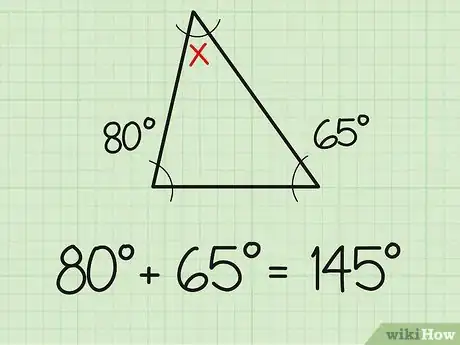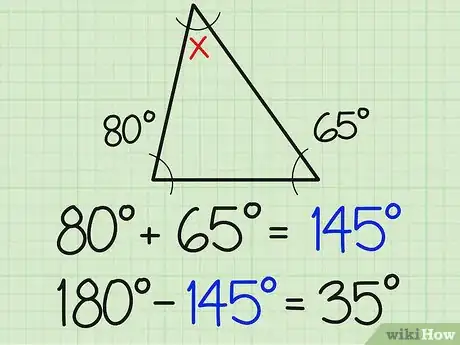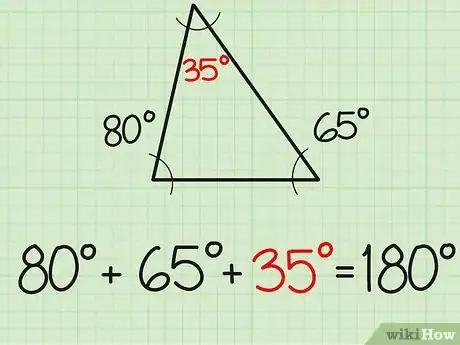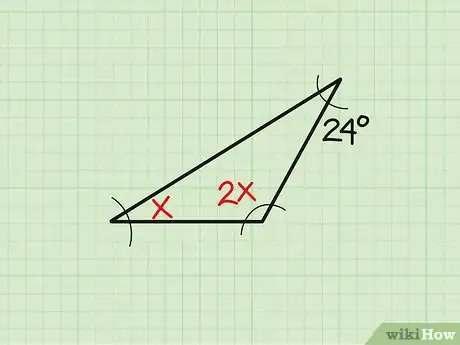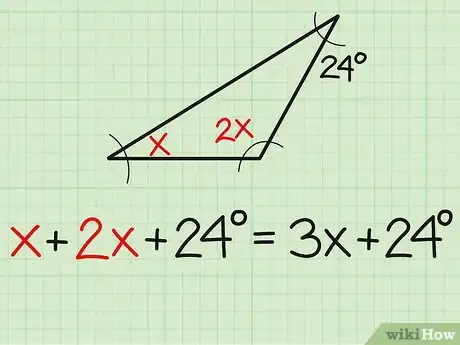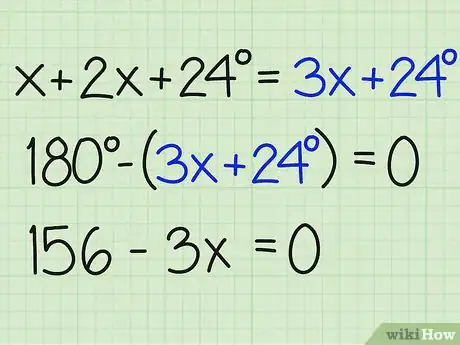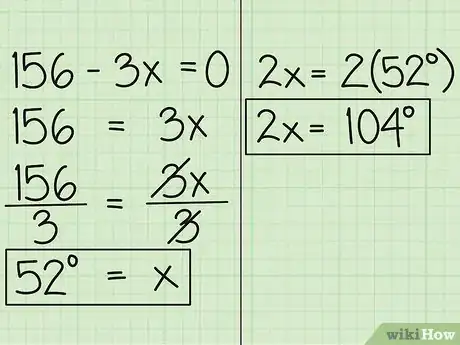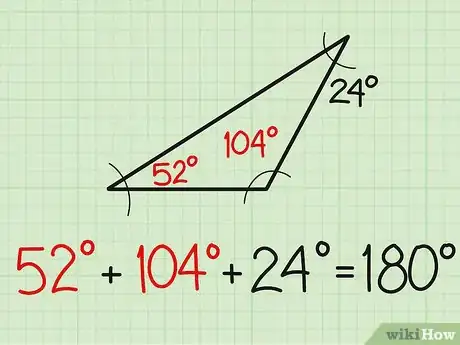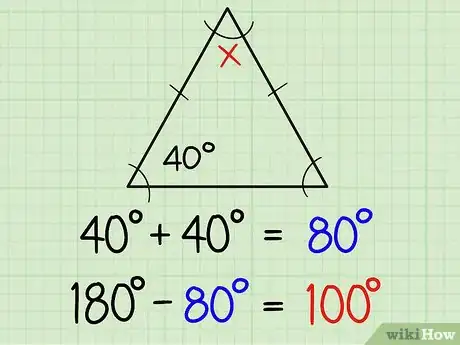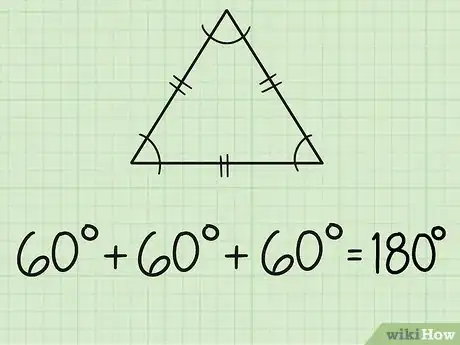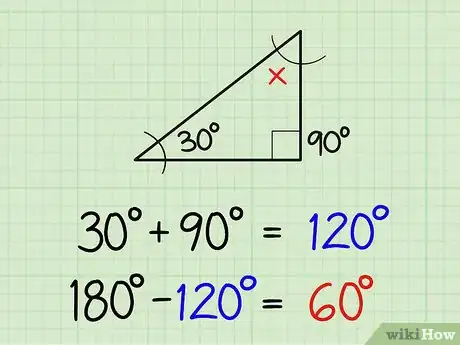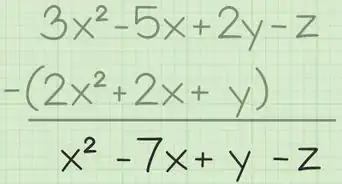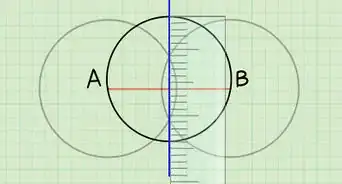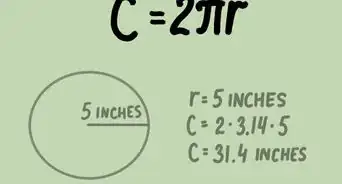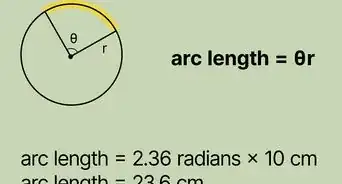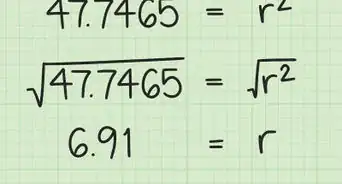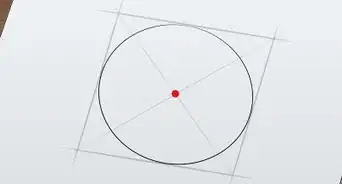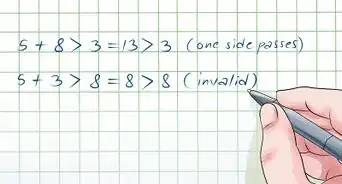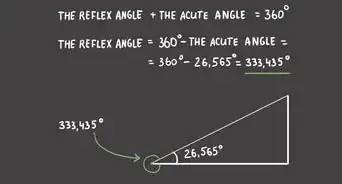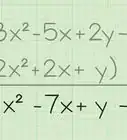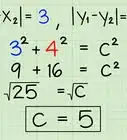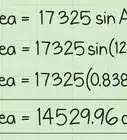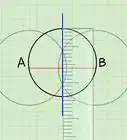wikiHow is a “wiki,” similar to Wikipedia, which means that many of our articles are co-written by multiple authors. To create this article, 24 people, some anonymous, worked to edit and improve it over time.
There are 7 references cited in this article, which can be found at the bottom of the page.
This article has been viewed 258,197 times.
Learn more...
Finding the third angle of a triangle when you know the measurements of the other two angles is easy. All you've got to do is subtract the other angle measurements from 180° to get the measurement of the third angle. However, there are a few other ways to find the measurement of the third angle of a triangle, depending on the problem you're working with. If you want to know how to find that elusive third angle of a triangle, see Step 1 to get started.
Steps
Using the Other Two Angles
-
1Add up the two known angle measurements. All you have to know is that all of the angles in a triangle always add up to 180°. This is true 100% of the time. So, if you know two of the three measurements of the triangle, then you're only missing one piece of the puzzle. The first thing you can do is add up the angle measurements you know. In this example, the two angle measurements you know are 80° and 65°. Add them up (80° + 65°) to get 145°.[1]
-
2Subtract this number from 180°. The angles in a triangle add up to 180°. Therefore, the remaining angle must make the sum up the angles up to 180°. In this example, 180° - 145° = 35°.[2]Advertisement
-
3Write down your answer. You now know that the third angle measures 35°. If you're doubting yourself, just check your work. The three angles should add up to 180° for the triangle to exist. 80° + 65° + 35° = 180°. You're all done.[3]
Using Variables
-
1Write down the problem. Sometimes, instead being lucky enough to know the measurements of two of the angles of a triangle, you'll only be given a few variables, or some variables and an angle measurement. Let's say you're working with this problem: Find the measurements of angle "x" of the triangle whose measurements are "x," "2x," and 24. First, just write it down.[4]
-
2Add up all of the measurements. It's the same principle that you would follow if you did know the measurements of the two angles. Simply add up the measurements of the angles, combining the variables. So, x + 2x + 24° = 3x + 24°.[5]
-
3Subtract the measurements from 180°. Now, subtract these measurements from 180° to get closer to solving the problem. Make sure you set the equation equal to 0. Here's what it would look like:
- 180° - (3x + 24°) = 0
- 180° - 3x - 24° = 0
- 156° - 3x = 0
-
4Solve for x. Now, just put the variables on one side of the equation and the numbers on the other side. You'll get 156° = 3x. Now, divide both sides of the equation by 3 to get x = 52°. This means that the measurement of the third angle of the triangle is 52°. The other angle, 2x, is 2 x 52°, or 104°.[6]
-
5Check your work. If you want to make sure that this is a valid triangle, just add up the three angle measurements to make sure that they add up to 180°. That's 52° + 104° + 24° = 180°. You're all done.
Using Other Methods
-
1Find the third angle of an isosceles triangle. Isosceles triangles have two equal sides and two equal angles. The equal sides are marked by one hash mark on each of them, indicating that the angles across from each side are equal. If you know the angle measurement of one equal angle of an isosceles triangle, then you'll know the measurement of the other equal angle. Here's how to find it:[7]
- If one of the equal angles is 40°, then you'll know that the other angle is also 40°. You can find the third side, if needed, by subtracting 40° + 40° (which is 80°) from 180°. 180° - 80° = 100°, which is the measurement of the remaining angle.
-
2Find the third angle of an equilateral triangle. An equilateral triangle has all equal sides and all equal angles. It will typically be marked by two hash marks in the middle of each of its sides. This means that the angle measurement of any angle in an equilateral triangle is 60°. Check your work. 60° + 60° + 60° = 180°.[8]
-
3Find the third angle of a right triangle. Let's say you know you have a right triangle, with one of the other angles being 30°. If it's a right triangle, then you know that one of the angles measures exactly 90°. The same principles apply. All you have to do is add up the measurements of the sides you know (30° + 90° = 120°) and subtract that number from 180°. So, 180° - 120° = 60°. The measurement of that third angle is 60°.[9]
Community Q&A
-
QuestionIn a right angle triangle, if one of the other two angles is 35 degrees, find the remaining angle.
 Community AnswerTake the 90, add it to 35. This gives you 125 degrees. Triangles can only ever add up to 180, thus take the difference of 125 and 180 (180-125). This will give you the third remaining angle, which in this case is 55.
Community AnswerTake the 90, add it to 35. This gives you 125 degrees. Triangles can only ever add up to 180, thus take the difference of 125 and 180 (180-125). This will give you the third remaining angle, which in this case is 55. -
QuestionIf one angle of a right triangle is 50 degrees, what will be the measurement of the third angle?
 Community AnswerA right angle triangle always consists of one 90 degree angle, and every triangle must equal 180 degrees. Here is the work for this problem: 90 degrees (representing the right angle) + 50 degrees equals 140 degrees. 180 minus 140 equals 40. Therefore, the remaining angle would be 40 degrees.
Community AnswerA right angle triangle always consists of one 90 degree angle, and every triangle must equal 180 degrees. Here is the work for this problem: 90 degrees (representing the right angle) + 50 degrees equals 140 degrees. 180 minus 140 equals 40. Therefore, the remaining angle would be 40 degrees. -
QuestionWhat if there is only one number?
 Community AnswerSubstitute a letter, and work it out like an algebraic equation that you have to solve.
Community AnswerSubstitute a letter, and work it out like an algebraic equation that you have to solve.
Warnings
- Making a mistake with addition and subtraction will result in a wrong answer. It's always a good idea to check, even if it doesn't appear to be wrong.⧼thumbs_response⧽
References
- ↑ https://www.softschools.com/math/geometry/topics/finding_the_3rd_angle_in_a_triangle/
- ↑ https://www.softschools.com/math/geometry/topics/finding_the_3rd_angle_in_a_triangle/
- ↑ https://www.softschools.com/math/geometry/topics/missing_angles_in_triangles/
- ↑ https://www.mathsisfun.com/algebra/trig-solving-triangles.html
- ↑ https://www.mathsisfun.com/algebra/trig-solving-triangles.html
- ↑ https://www.ck12.org/geometry/third-angle-theorem/lesson/Third-Angle-Theorem-BSC-GEOM/
- ↑ https://www.khanacademy.org/math/geometry/hs-geo-trig/hs-geo-pyth-theorem/v/pythagorean-theorem-with-right-triangle
- ↑ https://www.khanacademy.org/math/geometry/hs-geo-congruence/hs-geo-working-with-triangles/v/equilateral-and-isosceles-example-problems
- ↑ http://ncert.nic.in/ncerts/l/gemp106.pdf
About This Article
To find the third angle of a triangle, start by adding the other 2 angles together. Then, subtract that number from 180 to find the third angle. If the 2 known angles have variables, start by adding all of the measurements, including the variable used for the unknown angle. Then, subtract those numbers and variables from 180 and set the equation equal to 0. Finally, solve for the variable to find the third angle. If you want to learn the angles are on specific kinds of triangles, keep reading the article!
